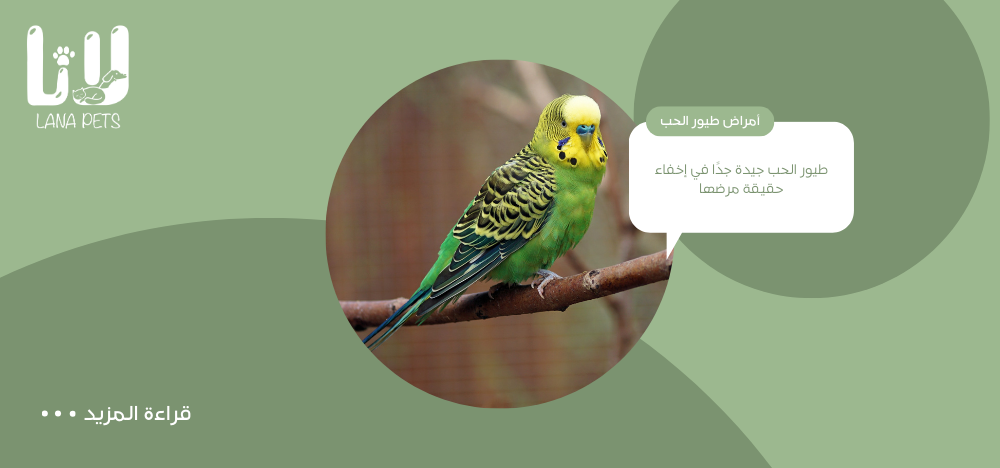
What are the most common lovebird diseases and how to treat them?
Lovebirds are very good at hiding the fact that they are sick. This behavior stems from their existence in the wild, where showing such vulnerability can make them a target for predators. Therefore, it is very important to observe the bird and learn its personality to have a better chance of detecting the disease.
The most common lovebird diseases and how to treat them
Below is a list of lovebird diseases that any lovebird breeder may encounter during the course of their bird's life:
Nutritional problems
One of the most common ailments lovebirds suffer from is related to their diet. This is primarily because they are seed addicts, and while this provides much of what they need in their diet, it can also lead to problems if not balanced with other foods.
The main reason for this is that seeds are high in fat. This can lead to obesity in birds, just as it can in humans. A seed-only diet can also lead to vitamin A and calcium deficiencies. Obesity can lead to fatty liver disease and arthritis.
How to treat nutritional diseases in lovebirds
Green leafy vegetables and fruits containing beta-carotene, such as apples and carrots, are safe ways to naturally introduce vitamins into your diet. Another option is a calcium block or liquid calcium in water.
Another option is to sprout seeds. This is a simple process where the seed uses the most fatty part to produce young plant shoots, leaving behind all the beneficial nutrients. It's a great nutritional balancer, and different sprouted seeds have different benefits. For example, oilseeds like rapeseed and niger are high in protein and carbohydrates, while starchy seeds like millet and canary seed are high in minerals, vitamins, enzymes, and chlorophyll.
Beak and feather disease is one of the most common diseases affecting lovebirds.
Lovebirds are one of the species most at risk for a condition called beak and feather disease (PBFD). This is a circular virus that infects and kills the cells that make up feathers and beaks. It also has a devastating effect on the immune system, potentially making the bird susceptible to further infections.
The disease can be fatal, or it can cause another deadly infection in itself. It can be transmitted from bird to bird, so any bird that may be infected should be immediately isolated from others. There is no known cure, but vaccines are being developed to help prevent infection.
Symptoms include:
- feather and beak deformities
- feather loss
- loss of appetite
- diarrhea
- regurgitation of food
Beak and feather abnormalities are the main visual sign that something is wrong and can include short, curled feathers, curly feathers, and misshapen feathers. In the beak, this appears as an enlarged upper beak, a misshapen shape, and a beak prone to splitting and breaking.
chronic egg laying
Laying eggs may not seem like a bad thing for a bird, but chronic egg laying can have serious long-term effects on a bird's health. Often, the eggs laid are infertile and are not laid because the bird has mated, but because another factor has made the bird believe it needs to produce and lay eggs.
The main reason why egg-laying is a disease in lovebirds and a cause for concern is that it leads to calcium deficiency. Simply put, a bird takes calcium from its body to make eggs, and if it lays eggs repeatedly and doesn't replace it, it can become ill.
Another part of the condition is egg binding due to a condition called hypocalcemia. This occurs when calcium levels are low, the uterine muscles fail to contract and the egg cannot be pushed out, leading to egg binding. Hypocalcemia can itself lead to seizures and osteoporosis, which can easily break.
How to treat it
You can't prevent a bird from laying eggs, but there are a few things you can do to either dissuade it from doing so or to ensure it is strong enough to survive. First, don't remove the eggs the bird has laid; let it finish laying and sit on them. The incubation period is usually around 21 days, so once it starts incubating, it won't lay eggs again, at least this time, allowing its body to recover. If you're concerned about the hygiene of the eggs around, you can get dummy eggs that look identical to the real thing but aren't.
Another thing to ensure is that your cat is getting plenty of calcium into their system to replenish what they use. This can be done through calcium blocks, water, or food. Oven-baked eggs, which are free of bacteria, are a good source of natural calcium and can be crushed into small pieces for easier digestion.
Respiratory diseases are the most common diseases of lovebirds.
Among the common respiratory diseases affecting birds, lovebirds are susceptible to aspergillosis, bacterial infections including pneumonia, and psittacosis.
Aspergillosis is a non-contagious but highly fatal fungal infection. It affects the respiratory system but can also spread to other organs at various stages. It can be controlled if detected early enough and treated with antifungal medications.
Polyoma is another respiratory disease that affects young birds and is transmitted from one bird to another, possibly also via the egg. It begins with feather deformities, loss of appetite, and delayed moulting. It can lead to bleeding from the follicles where feathers develop and is treatable if caught early enough.
In short, sometimes birds get sick despite our best efforts to stop it, and there's nothing we can do. But by knowing your bird's personality, you have a better chance of detecting lovebird illnesses and determining when something might be wrong and when it should be brought to Lana Veterinary Clinic for prompt treatment before it's too late.

